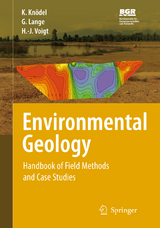Environmental Geology
Springer Berlin (Verlag)
978-3-540-74669-0 (ISBN)
As earth's population continues to grow and the detrimental aftereffects of industrialization and environmental negligence become more apparent, society has become more aware of, and concerned about, stewardship of the natural environment - water, soil, and air. Sustainable development has become more widely received and promoted in many parts of the world. The need is now critical for earth and environmental scientists and engineers to work together to implement technologies that can preserve our environment. The Earth's population was 6.6 billion as of April 2007 according to the U.S. Census Bureau. This number is expected to rise to 9.4 billion by 2050. The population is increasing the demand for natural resources and energy, and increasing stress on the environment. Thus, protection of the environment and remediation of damage to the environment must be a priority. It is also important to develop procedures that will help to avert further damage to the environment and to recognizeas early as possible the risks associated with changes in the environment. Many methodologies and technologies have become more advanced in the past few decades, and new technologies and approaches have been developed, all to address the growing need for environmental assessment, monitoring, and remediation. As these technologies have grown, the need for interdisciplinary cooperation has also become more apparent. Specialists in remote sensing, geophysical methods, hydrogeology, geology, and geochemistry must maintain current awareness of developments within their sister disciplines in order to formulate effective overall approaches for environmental issues.
Preparatory Steps and Common Problems.- Preparatory Steps and Common Problems.- Remote Sensing.- Aerial Photography.- Photogrammetry.- Nonphotographic Imaging from Aircraft and Space-borne Platforms.- Geophysics.- Magnetic Methods.- Gravity Methods.- Direct Current Resistivity Methods.- Electromagnetic Methods.- Ground Penetrating Radar.- Seismic Methods.- Surface Nuclear Magnetic Resonance.- Borehole Logging.- Geophysical In-situ Groundwater and Soil Monitoring.- Geological, Hydrogeological, Geochemical and Microbiological Investigations.- Methods for Characterizing the Geological Setting.- Methods for Characterizing the Hydrologie and Hydraulic Conditions.- Methods for Characterizing the Geochemical and Microbiological Conditions.- Interpretation of Geological, Hydrogeological, and Geochemical Results.- Integration of Investigation Results.- Data Fusion.- Joint Interpretation.
| Erscheint lt. Verlag | 12.11.2007 |
|---|---|
| Zusatzinfo | XXVI, 1357 p. |
| Verlagsort | Berlin |
| Sprache | englisch |
| Maße | 155 x 235 mm |
| Gewicht | 2025 g |
| Themenwelt | Naturwissenschaften ► Biologie ► Mikrobiologie / Immunologie |
| Naturwissenschaften ► Geowissenschaften ► Geologie | |
| Weitere Fachgebiete ► Land- / Forstwirtschaft / Fischerei | |
| Schlagworte | Biology • Borehole • Environmental Geology • Fundament • Geochemistry • Geologie • Geophysics • groundwater • hydrogeology • Hydrology • Landfill • Microbiology • Remote Sensing • site investigation • Soil |
| ISBN-10 | 3-540-74669-2 / 3540746692 |
| ISBN-13 | 978-3-540-74669-0 / 9783540746690 |
| Zustand | Neuware |
| Haben Sie eine Frage zum Produkt? |
aus dem Bereich




